Author Archive
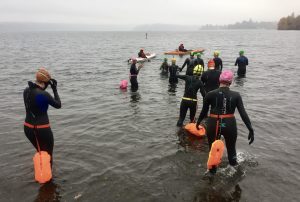
Want to experience the “cold water high”? Here are early tips to make your winter swimming joyful and safe.
How Cold is Too Cold? How Long is Too Long?
Keep these 5 guidelines in mind:
- Acclimate with repeated short exposures.
- Accept that everyone is different. There is no universal “right amount of time or distance” to achieve comfort.
- Know that your acclimatization, body mass, what you ate for breakfast, hormone levels, emotional state, and other factors play a part in your reactions to cold water. What was true yesterday may not be true today.
- If you shiver while in the water, get out immediately. Shivering helps you warm up once you’re dry, but indicates a dangerous level of cold before then.
- Be even more cautious when it’s windy. Wind reduces your temperature amazingly fast, especially when your skin is wet.
For winter swimming, a general, guiding principle is simply “be conservative.” For excellent info about hypothermia, watch this video from the South End Rowing Club in San Fransisco.
Equipment
Extra neoprene is good: wetsuit, booties, gloves, cap. If you swim “skin” (wetsuit-free) just your suit, goggles, and a bright cap will do. Silicone earplugs are a MUST for many. And don’t forget your swim buoy and a towel or two.
Warm Up After Your Swim
What to Wear & Eat: Dry yourself ASAP and dress from the top down: put your knit cap on first. Then, layer up with thick socks, warm shoes, and sweaters/jacket/parka. Drink something warm and consider eating something sweet. Doughnuts definitely fit the bill.
What to Do: Stand on something to prevent further heat loss while you dress. Do squats, burpees, or jumping jacks. Then find a warm place to sit. Do not drive until your brain feels normal again-possibly as much as 20-30 minutes after you exit the water.
Swim Smart!
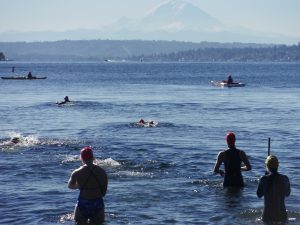 The rush of feel-good hormones after a swim is highly addictive, to be celebrated and enjoyed. But remember: If open water swimming is inherently risky, doing so in winter is even more so. Winter swimming may help build immunity, reduce your risk of heart disease, and give you joy. Just be smart.
The rush of feel-good hormones after a swim is highly addictive, to be celebrated and enjoyed. But remember: If open water swimming is inherently risky, doing so in winter is even more so. Winter swimming may help build immunity, reduce your risk of heart disease, and give you joy. Just be smart.
Happy swimming!
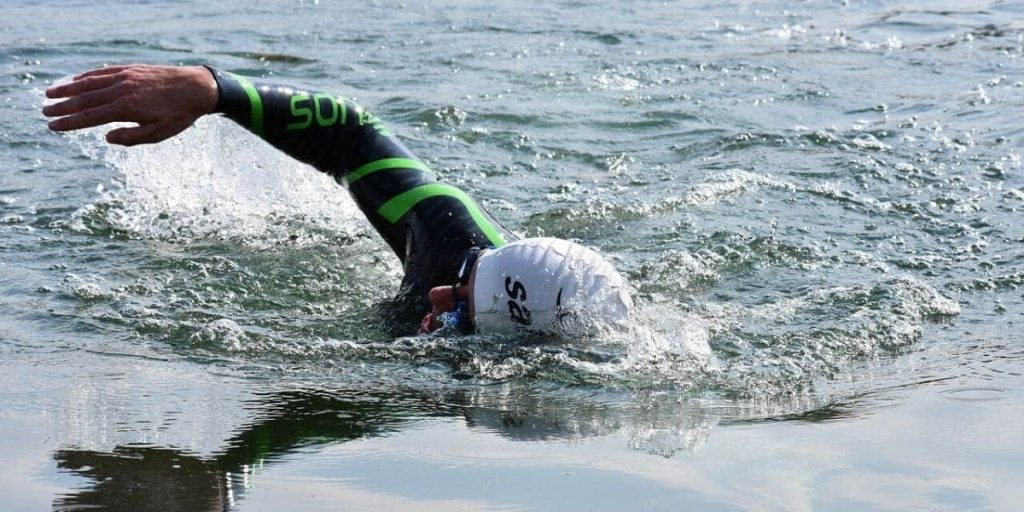
Welcome to a rarified world of those who swim during the colder months. I have been blown away by the number of swimmers who have contacted me about taking lessons far into the Fall, for the following reasons:
- Baby, it’s cold outside (duh).
- There are more dangers BECAUSE it‘s cold.
Please read the following before deciding to register.
Info About Say Yes to Life Swims (SYTLS)
In 2023, we celebrate our 12th year helping people discover their best selves in the open water. All events and coaching sessions are insured. Here are more details about my training and experience as an open water swimming coach.
Fall Coaching and Lessons
All lessons take place at Colman Park. After you register, I send you a Welcome Letter with essential details.
Guidelines
Swimmers must:
- Be able to swim at least 10 minutes in a pool. The “quality” of your stroke doesn’t matter, but your endurance and ability to move ahead in the water does.
- Bring and wear all the neoprene you can. Water temp can hover between 50-60 degrees. If you are used to swimming in the Salish Sea or other salt water, the lake may feel colder, even at the same temperature.
- Agree to potentially keeping our “in-the-water time” to 20 minutes. You will get the entire 45 minute lesson, but depending on your experience in cold water, we MAY limit your exposure to 20 minutes.
- Watch this Virtual Open Water Clinic. Info starts about four minutes in.
Again, here’s the registration link. Feel free to share it with others.
Let me know if you have questions.
And…if I don’t see you until the sun comes out later this year, Happy Swimming!
— Guila
(pronounced “Ghee-lah”)
Do you want to: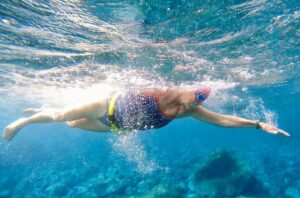
- Improve your stroke’s effectiveness and power?
- Be more sleek and efficient in the water?
Practicing the right drills will help you achieve these goals.
Why Drill?
Swimming creates neural pathways, enabling us to swim without constantly thinking about what we are doing. Doing drills makes us more aware of our movements so we can correct problems we may not even know we have. Personally, I (Guila) LOVE to do drills. It delights me to focus on body awareness instead of speed.
DRILLS Workshop Information
The session is limited to TEN swimmers.
When: 9:00-11:00 am, Sunday, July 16th 2023
Where: South Seattle. Address provided to registered swimmers.
Cost: $85
Two Ways to Register:
Before registering, please write me to ask about remaining slots. If we have reached capacity, we will inform you and put your name on a waiting list for a (potential) second workshop later in the season.
Preparation:
- Keep up your open water and pool swimming
- Watch 2-3 short videos (links sent to registered swimmers)
- Participate in the Safety Meeting (provided onsite)
We hope to see you there!
Get inspired by learning how these swimmers conquer the most daunting, treacherous and exciting open water feats in the world. They are absolutely amazing.
Watch the webinar.
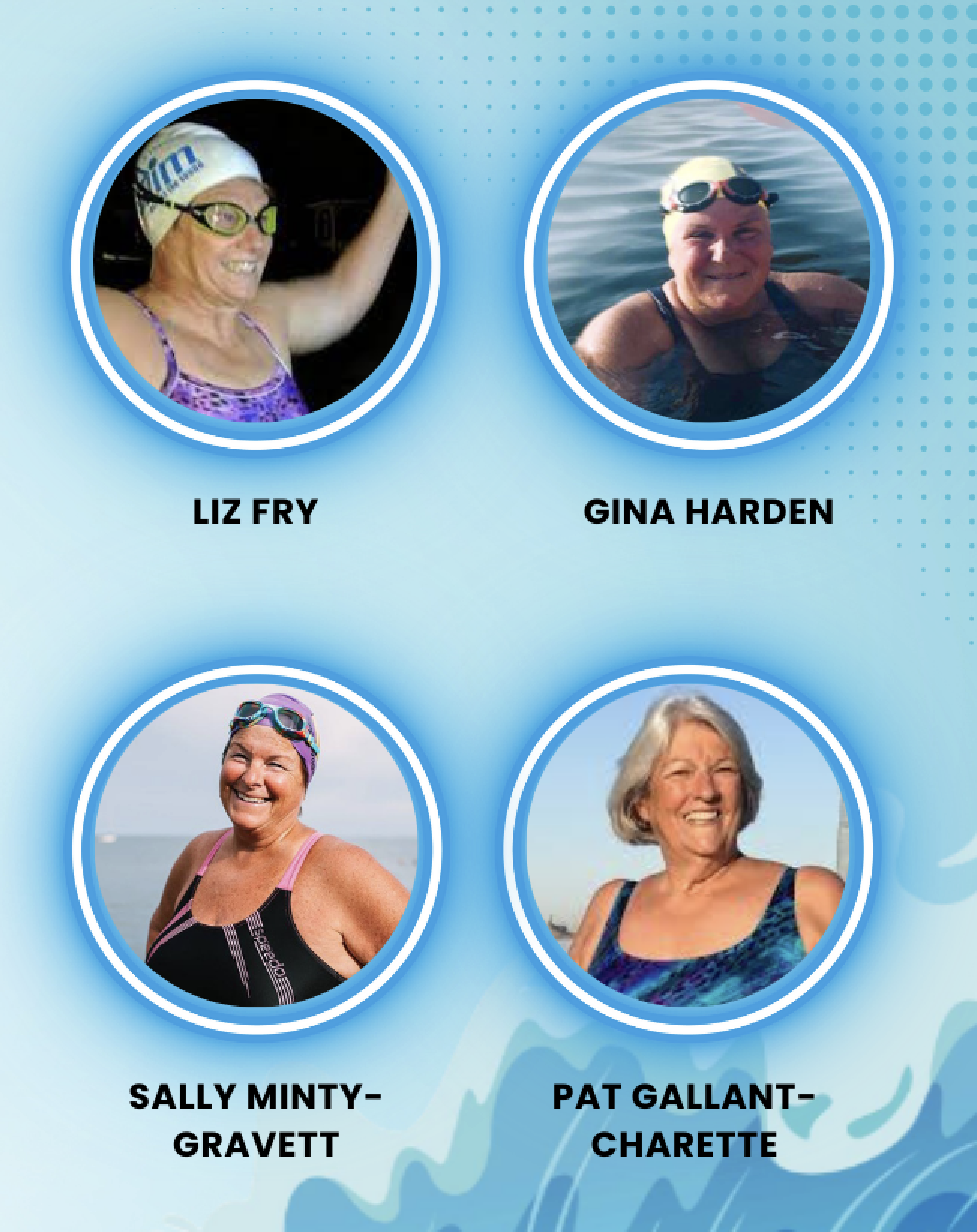
FREE! LIVE WEBINAR
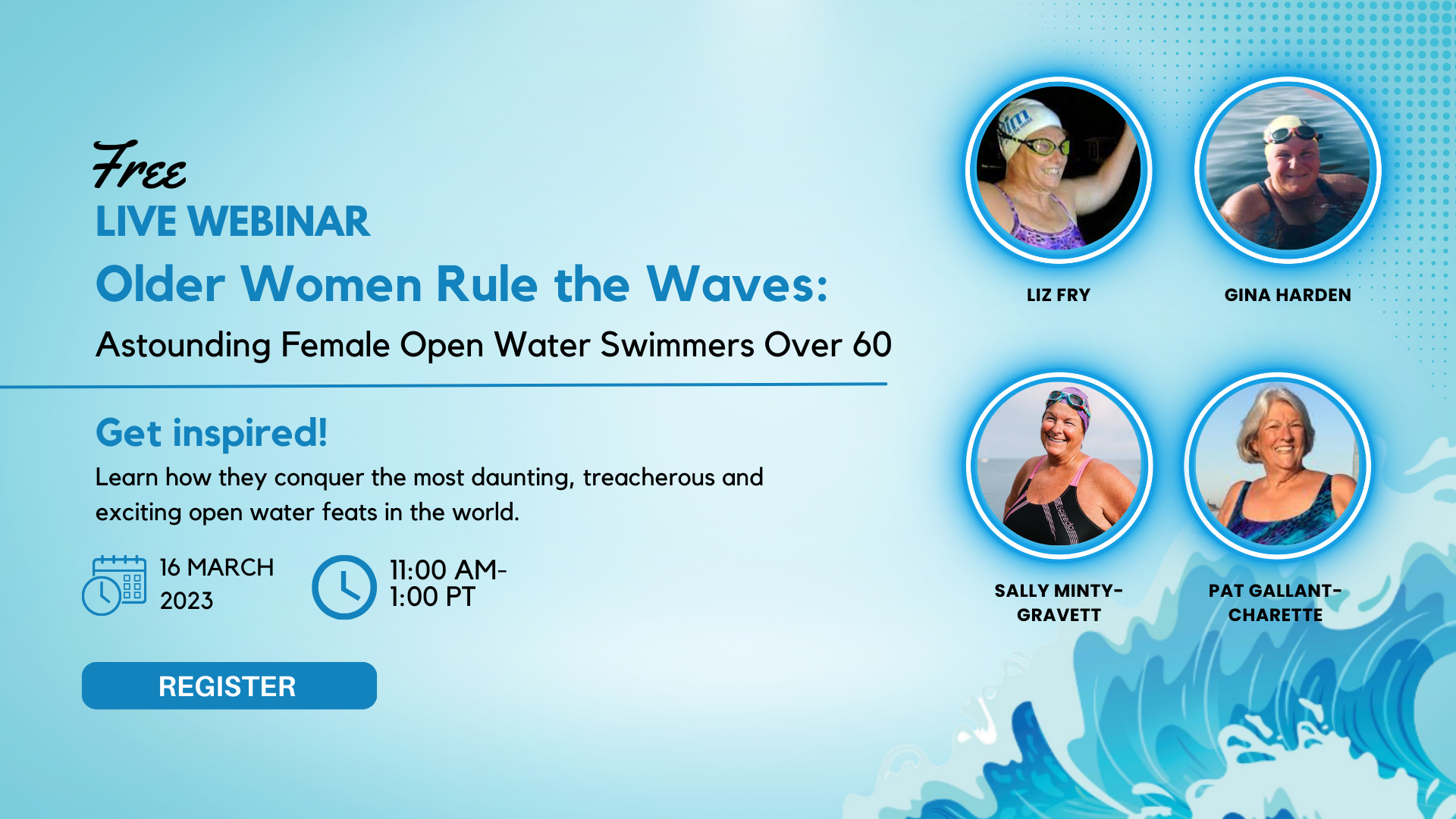
Get inspired! Hear about their adventures and learn how they conquer the most daunting, treacherous and exciting open water feats in the world.
WHEN: 11:00 am-1:00 PT March 16th 2023
REGISTER HERE
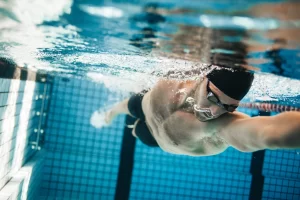 On the first weekend this January, with Omicron raging and the skies pouring, I sat double-masked in the back of a conference room. It was the third and final day of the ASCA (American Swimming Coach’s Association) conference.
On the first weekend this January, with Omicron raging and the skies pouring, I sat double-masked in the back of a conference room. It was the third and final day of the ASCA (American Swimming Coach’s Association) conference.
Everything was dark and gloomy, including my mood. The rain was endless, the hotel under construction and swathed in dripping plastic sheets. The conference room, where we sat for hours watching PowerPoint after PowerPoint, was particularly dismal. No one ever seemed to smile or even speak from beneath their masks. I felt lonely, depressed, and alienated.
THEN! In that last hour, the presenter, a coach at a prestigious university, said something that caused me to bolt upright. (I almost heard a “ding-ding-ding” in my head! ) As he rambled about things he tells athletes, he said:
“The nose should point down before the catch begins.”
He went on to say “Most swimmers I work with need to slow down their stroke to become aware of its four sequential parts:
- Hand in water
- Breathe
- Head back down (while exhaling)
- Catch. Swimmers should start the catch only when the head is in line.”
In other words, the nose should be parallel to the pool’s (or lake’s, or ocean’s) bottom before each catch begins. Doing this involves a VERY quick flip of the head.
I scribbled down this sequence, escaped into the rain, and tried these four steps in the hotel pool. I was shocked how challenging it was to complete the sequence while breathing on my left. It seemed natural to want to take a nice huge breath on that side, but trying to get my face down first precluded doing so.
The Effect
Yes, I’ve been practicing ever since. What have I noticed?
- I’m not so flat in the water. I finally feel as if my body is rotating around a skewer.
- I’ve sped up.
- I feel sleeker and more coordinated. All the “parts” of swimming seem to fit together better.
- My timing and rhythm have improved.
Now I feel that the depressing conference experience was well-worth my money and participation. And all of this just from that one sentence: Get that nose facing straight down before each catch.
Everyone gets “Ah-hahs” for different things at different times, and maybe this revelation rocks only MY world. I hope it helps others as well! Happy Swimming to all, and let me know about your experiences.
Triathletes, how do you find (or keep) your open water mojo?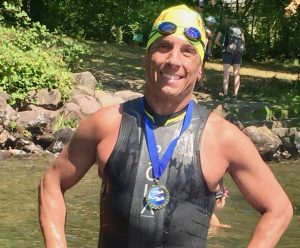 To stay on top of your game, you must train in the open water. Learning to deal with chop, waves, wind, and current will prepare you for your triathlon like nothing else.
To stay on top of your game, you must train in the open water. Learning to deal with chop, waves, wind, and current will prepare you for your triathlon like nothing else.
Three Tips for Success
1. Practice outside early. Start practicing outdoors early in the season. Because you are immersing early, you absolutely must acclimate. Cold water robs the body of heat 32 times faster than cold air. Stay in a maximum of ten minutes at first. Extend your distance and duration each time.
Expect to feel an “ice-cream” sinus headache during your first few minutes in the water. Your face may hurt. Relax and be patient…like many things in triathlon, pain is part of the process. Remove your swimsuit and wetsuit quickly once you exit the water. Because of vasoconstriction, you may feel colder 15-30 minutes after your swim than you did while swimming.
If you are combining your swim with a run, always swim first. Triathletes who run first risk feeling uncomfortably cold in the water.
Eventually set a goal of completing 80%-90% of your race distance, and celebrate when you achieve it.
2. Use appropriate gear. The following gear will help you get a leg up on your competitors.
- Professionally fitted wetsuit. Eschew on-line purchasing; a careful fitting is important. Warning: Although your wetsuit provides buoyancy, it is not a Personal Flotation Device (PFD). Wearing one will not save your life.
- Neoprene cap. This protects you in the early season. Pull a bright latex or silicone cap over it to increase your visibility.
- Swimmer Safety Device. Swimmers can usually see boaters, but boaters often cannot see swimmers. Buckling around your waist and trailing behind you, Swimmer Safety Devices make you more visible in the water. Like wetsuits, they are not meant to be used as PFDs.
3. Swim with experienced paddlers. It’s best to train with a group, but even better to swim with an experienced kayaker. Your kayaker must carry an extra PFD for you. They should know CPR and carry a phone in case of emergency.
Challenge yourself! Watch this video for all the info you need to kick off your training, and read this article from the Seattle Times. Keep track of your times, and try to beat them.
Triathletes, happy training! See you in the water.
Guila Muir is the founder of Say Yes! to Life Swims LLC, the Northwest’s premiere source of escorted open water swims. Join us to practice sighting and swimming in a pack while you test your endurance and open water skills!
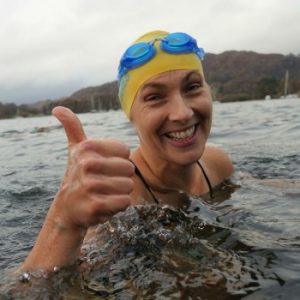 New to the open water? This lively clinic provides tips which often take years to learn! Learn about equipment, strategies, and more.
New to the open water? This lively clinic provides tips which often take years to learn! Learn about equipment, strategies, and more.
Annika Fain, of Seattle Outdoor Sister, interviewed Guila recently. Their conversation ranges from Guila’s early swim experiences to what’s going on with Say Yes to Life Swims, eight years into its existence. Listen and enjoy!
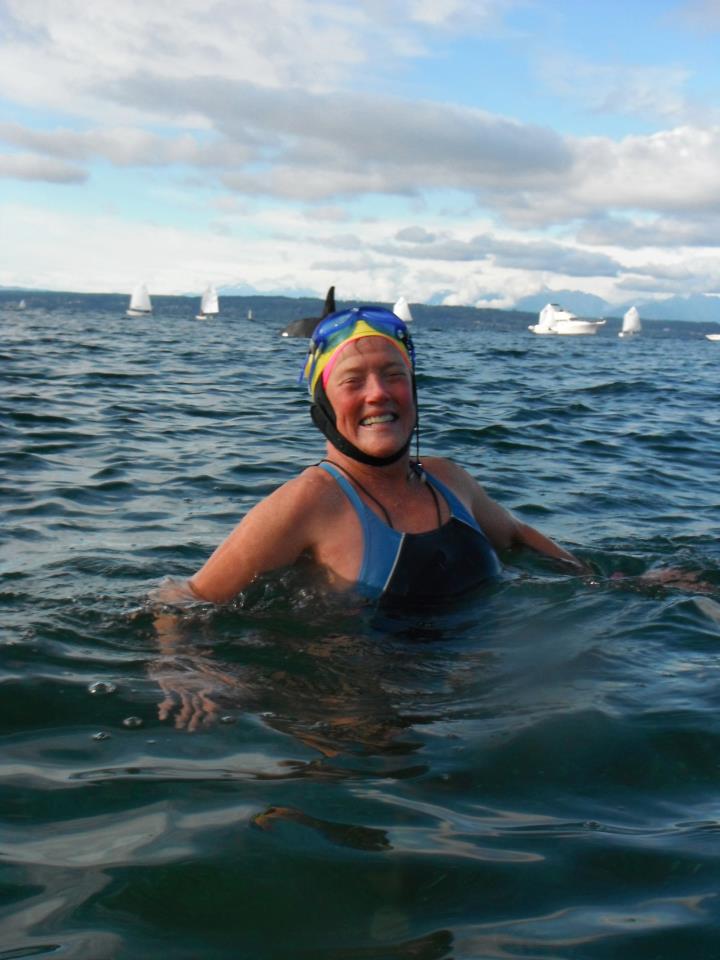
Is that an orca in the background?
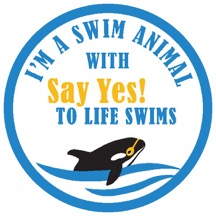
Introduction
I came to swimming later in life. All its aspects fascinated me, so I embarked on my own informal “adult learning project”, which continues through today. My project includes reading everything I can get my hands on, particularly about open water swimming, as well as interviewing swim teachers about their views, beliefs, and approaches.
“Swimming Doesn’t Come Naturally” to Humans
During my talks with swim and triathlon coaches, I hear a recurring theme. Many of them state that for humans, “swimming isn’t natural”. With the hope of assuaging new swimmers’ awkwardness, I have sometimes expressed this sentiment myself. Renowned author and lifeguard Frank Pia has written, “We are…ill-equipped in both movement and survival in the sea and lakes that consume the vast majority of our planet.”[1]
It’s true that the human form, with its powerful gluteal muscles, excels at running. Thanks to being primates, we’re also good climbers. In living our lives day-to-day, we primarily keep our bodies vertical, moving in the sagittal plane. In fact, drowning people typically keep their bodies vertical as they try to “climb” out of the water.[2]
The mysterious nature of water ignites a primeval fear in many of us. A 1998 Gallup poll found that 46% of American adults are afraid of deep water in pools, while the CDC estimates that 37% of adults cannot swim. [3
Busting the Myth: We Are Built to Swim!
However, these facts have little to do with the fact that our bodies are as designed to swim. People have been swimming since there were people on earth. Paintings dating to 2500 BCE depict people swimming in the River Nile (Figure 1), and the first recorded swimming races were held in 36 BC, in Japan. [4] The mammalian dive reflex (known as “our inner dolphin” and exploited by free divers) allows us to exist underwater for extended periods of time.
In recent years, swimming is receiving an explosion of interest, particularly by the aging population. Many baby boomers have discovered or re-discovered swimming as a challenging, yet non-weight-bearing exercise. [5] Swimming works the great majority of the muscles in the human body. [6] And, unlike many other “percussive” sports, people into their late 90’s are still able to exercise by swimming.
Lastly, open water swimming is enjoying a popular resurgence that it hasn’t experienced since the 1920’s, when Gertrude Ederly was the first woman to swim the English Channel, starting an open-water swimming craze. Currently, there are an estimated 25,000-30,000 organized open water events held annually around the world, and unprecedented solo swims and relays occur all over the globe. [7]
So, swimming is super-popular! And I’ve always been curious as to how it actually works. Specifically, what are the mechanics of the catch and pull phases of the freestyle stroke? That’s what I set out to discover in this paper.
Methods
My friend Carolyn kindly volunteered to be my subject. Carolyn is a recently retired, 65-year-old lifelong swimmer and swim coach. Two to three times a week, Carolyn swims approximately 2500-3000 yards in the pool. In recent years, she has also completed multiple open water swims of up to 7 kilometers in Lake Washington.
To gather data for this paper, I used my iPhone to video Carolyn at both Medgar Evers and Rainier Beach public pools in Seattle, Washington. Filming her underwater proved to be too much of a challenge, particularly during the pull phase when I would need to film her from below. Besides, I was interested in obtaining clear documentation of the mechanics of just her shoulder and arm, not her entire body.
Analysis and Breakdown of the Catch and Pull Phases
Overview: Bones and Muscle
Before describing the specific movements of the catch and pull phases, I’d like to provide a quick overview of the bones and muscles that freestyle uses. In general, freestyle stroke uses the bones and muscles of the shoulder girdle (clavicle and scapula) and arm (humerus, radius, and ulna). Most of the movements for the freestyle stroke also involve the glenohumeral joint, the ulnohumeral joint and radioulnar joint. The deltoid is the primary muscle involved in changing the position of the humerus, and thus the entire arm.
Unique Dynamics of the Freestyle Stroke
The freestyle stroke is one of constant, repetitive rotation. There is really no beginning or end to the movement, and the stroke truly involves the entire body. In this paper, I isolate and analyze the movement of just one arm during the catch and pull phases. The actions are the same for the opposite arm.
I am not going to describe the recovery portion of the freestyle stroke except to say that the same stabilizers (pectoralis minor, rhomboids, levator scapula, middle and lower trapezius, and the serratus anterior) work with the deltoid and rotator cuff to reposition the arm during that phase.
From my research, I found that the serratus anterior is active during all phases of the entire stroke, providing ongoing stability to every movement of the freestyle stroke. Elbow flexion and extension also occur throughout the entire stroke.
Purpose and Description of the Two Phases
Catch
- Purpose
To allow the hand, wrist, elbow and arm to enter the water and set up for a powerful pull.
- Description
Starting Position: The catch begins with the arm extended to its outer range in the superior transverse plane.
The scapula, in upward rotation, works together with the clavicular portion of the pectoralis major to begin the arm’s eccentric contraction. From this position, the upper trapezius helps to elevate the scapula while the rhomboids retract it. The shoulder joint medially rotates as the deltoid holds the upper arm high. The elbow flexors begin to slightly concentrically contract. The wrist flexors hold the wrist in a position of slight flexion.
Finally, the hand enters the water, fingertips first. (Figure 3).
In the shoulder, the agonists are the pectoralis major, subscapularis, latissimus dorsi, and teres major. The antagonists are the anterior deltoid, coracobrachialis, and biceps brachii, while the rotator cuff (infraspinatus, teres minor, supraspinatus, subscapularis) stabilizes the entire shoulder.
In the elbow, the agonists are the bicep, biceps bracchi, and brachialis, while the tricep acts as the antagonist.
Pull
- Purpose
To propel the swimmer forward. The pull, (or as Olympian Sheila Taormina describes it, “the diagonal motion toward the body”) is the stroke’s power phase.
- Description
Starting position: The pull phase begins in the anterior transverse plane. The full hand is submerged in the water, palm down and moving inferiorly.
The scapula depresses and the shoulder stays in its medial rotation as the elbow concentrically contracts into approximately 30 degrees of flexion. At this point, the arm is moving below the trunk of the body, pushing backwards on the water. The trapezius and latissimus dorsi adduct the flexed arm toward the midline. Wrist flexors hold the wrist in a position of slight flexion.
Where the power comes from: The wrist, forearm, and upper arm work together to comprise one half of a third-class lever, while the upper arm comprises the other half. The adduction of the bent arm (lever) in the sagittal plane under the body is what “holds” the water, applying backward force to move the body forward. (Figure 5)
The propulsive forces generated by the lever rely on the scapula’s having a firm base of support. The pectoralis minor, rhomboids, levator scapula, middle and lower trapezius, teres minor, and the serratus anterior work together to stabilize the scapula.
The clavicular portion of the pectoralis major and the latissimus dorsi generate the majority of force during the pull. The latissimus dorsi, pectoralis major (upper and lower fibers) deltoid anterior fibers, muscles of the rotator cuff, and the coracobrachialis act as agonists. The antagonists are the tricep and deltoid posterior fibers.
The pull finishes with the hand exiting the water in the posterior transverse plane, at the hip. The wrist is in full extension with palm facing inferiorly. The subscapularis, superior middle deltoids, and supraspinatus are the agonists, while the biceps are the antagonists.
Conclusion
The art of swimming is complex. It comprises multiple, simultaneous muscle movements. Contrary to widely-held beliefs and fears, swimming can be considered “natural” for the human body, and history shows us that humans have swum for thousands of years. Swimming is a skill that people of all ages, and many ability levels, can learn.
Understanding how the shoulder, arm and wrist work together during freestyle may help both novices and advanced swimmers improve their stroke.
I am an advocate for the joy of swimming. Alexandr Popov, one of the world’s fastest swimmers, describes swimming this way : “The water is your friend…you don’t have to fight with water, just share the same spirit as the water, and it will help you move.”
Books and Resources used for This Paper
Colwin CM. Breakthrough swimming. Champaign, IL: Human Kinetics. Retrieved from https://www.ncbi.nlm.nih.gov/pmc/articles/PMC3438875/
Kinesiology and biomechanics of the freestyle stroke (part one). Retrieved from https://www.underwateraudio.com/blogs/swimming-and-fitness-blog/kinesiology-biomechanics-freestyle-stroke
McLeod, I. (2010). Swimming Anatomy. Champaign, IL: Human Kinetics
Mortimer, G. (2008). The great swim. New York, NY: Walter & Company
Planes of movement. Retrieved from https://www.swimmingscience.net/swimming-science-resources/
Taormina, S. (2010). Swim speed secrets for swimmers and triathletes. Boulder, CO: Velo Press.
Tarpinian, S. (1996). The Essential Swimmer. Guilford, CT: Lyons Press
Tough, A. (1979). The adult’s learning projects: a fresh approach to theory and practice.
[1] Swimming: Is it Natural or Learned? Retrieved from Caveman World http://www.cavemenworld.com/explore/swimming-is-it-natural-or-learned/
[2] Recognizing Drowning, Retrieved from https://www.outdoorswimmingsociety.com/recognising-drowning/
[3] How Many Americans Can’t Swim? Retrieved from http://www.slate.com/articles/news_and_politics/explainer/2010/08/how_many_americans_cant_swim.html
[4] Swimming. Retrieved from https://www.encyclopedia.com/sports-and-everyday-life/sports/sports/swimming
[5] Aging Swim Lessons and the Benefits of Swimming in Later Life. Retrieved from https://bloomerboomer.com/aging-swim-lessons-and-benefits-of-swimming-in-later-life/
[6] Does Swimming Work Every Muscle? Retrieved from https://livehealthy.chron.com/swimming-work-muscle-3713.html
[7] A Voice for the Sport: Open Water Swim Explosion. Retrieved from https://www.swimmingworldmagazine.com/news/swimming-world-presents-a-voice-for-the-sport-open-water-explosion/)
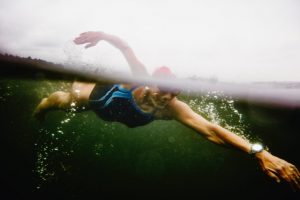
In 2016, several amazing Northwest women swimmers made news doing the nearly impossible. This forum will highlight their triumphant stories. Whether you dream of swimming in the open water yourself or simply want to learn more about this challenging sport, you are invited for a memorable evening.
FREE, and open to all, this event is the first in a series of Springtime educational offerings.
When: Friday, March 24th, 2017
Where: C&P Coffee, Seattle
Our generous panelists are:
- Wendy Van De Sompele (circumnavigated Maury Island, WA)
- Erika Norris (swam from Bremerton to Seattle)
- Jessi Harewicz (swam the Georgia Strait, Canada)
- Melissa Kegler (swam the Catalina Channel and is preparing to conquer the English Channel in 2017)
Say Yes to Life Swims is the Northwest’s only business providing Escorted Open Water Swim Adventures.
Sign up for the Say Yes to Life Swims Newsletter for tips and techniques to improve your open water swimming. See you in March!
 Does the thought of swimming outdoors make you start hearing the soundtrack from the movie “Jaws”? If so, you are not alone. The good news is that countless swimmers have conquered their fears. They have discovered the uniquely rewarding activity of swimming in the natural world.
Does the thought of swimming outdoors make you start hearing the soundtrack from the movie “Jaws”? If so, you are not alone. The good news is that countless swimmers have conquered their fears. They have discovered the uniquely rewarding activity of swimming in the natural world.
You Can Do It!
First things first: You will never see a pointy fin swimming toward you in Northwest lakes and coastal waters. We are blessed with some of the finest, clearest, most swimmable bodies of water in the world. Follow the tips below to increase your confidence and competence in the open water.
Three Tips to Enhance Your Enjoyment
1. Take It Slowly
Even if you can swim long distances in the pool, swimming outdoors is entirely different. There is no line on the bottom to guide you and no walls to hem you in. Experienced open water swimmers love this freedom, and you will learn to cherish it, too.
However, do take things slowly. The key to comfort in the open water is smart acclimatization. Water temperature above 67 degrees Fahrenheit will feel most comfortable, so don’t be shy about taking a thermometer (one from a hot tub works well) down to water’s edge.
To acclimate properly, make your first swims very short—maybe only three to five minutes. Most people acclimate fairly rapidly, and can soon extend their time in the water. Bring plenty of warm clothes to change into, even if the sun is high.
By taking steps to keep comfortable, you will relish returning to the open water—filled with confidence instead of trepidation.
2. Be Seen
New open water swimmers can be narcissistic. That is, they think the whole world is looking at them! Take it from the most experienced swimmers in the world: Jet skis, power boats, and most anything else in the water (including other swimmers) cannot see you at all, no matter how bright your swim cap.
The importance of being seen in the water cannot be overstressed. Always swim close to shore, and wear a Swim Safety Device (often called The ISHOF SaferSwimmer Float) to increase your visibility. Swimming with friends helps make you more visible, and increases the fun you have as well.
3. Stay Calm
Stay calm and swim on! Even experienced open water swimmers may hyperventilate a little upon entering the water. This phenomenon (called the Mammalian Dive Reflex) is totally normal. Be patient, remain calm, and your breathing will return to normal within minutes.
The trick to overriding anxiety is to enter the water slowly. Don’t start swimming until you have fully immersed your face and head several times. You’ll be surprised how quickly you begin to start to feel like a sea mammal, totally comfortable in your environment.

Have Fun!
These tips will help you become an accomplished and confident open water swimmer. All you need to do is follow the tips above and take the plunge. Like many other happy summer swimmers in the Northwest, you may well discover a new life passion.
Guila Muir is the founder of Say Yes to Life! Swims, a Northwest company providing escorted open water swim adventures and outdoor swim lessons. Contact her at www.sayyestolifeswims.com.
 The May 2015 issue of Seattle Magazine includes an article featuring Say Yes! to Life Swims.
The May 2015 issue of Seattle Magazine includes an article featuring Say Yes! to Life Swims.
The four-page article in the magazine’s Health section focuses on a recent trend among Seattle women of making exercise a social activity. Author Sheila Cain discusses the benefits of socially-focused physical activities, which include motivation, camaraderie, community-building, and of course, fun.
As the article points out, exercise is just one benefit of group physical activity. “(T)he most common outcome is the sense of community that comes from the … gatherings.” Friendships, community, and fun don’t just help us start exercising and keep exercising: the social aspects of Say Yes to Life Swim Excursions are a health benefit in and of themselves.
Cain cites a 2012 study by the Society of Behavioral Medicine that found “people participating in aerobic activity worked out twice as long when they were with a partner than if they were exercising on their own”. She also points out that those who exercise as part of a group are more likely to show up in the first place. Stands to reason: it’s a lot harder to opt to stay home when you know your friends are expecting you.
If you’ve been wondering whether open water swimming might be for you, now is a great time to come give it a try. We’ve got an exciting lineup of Excursions scheduled for the 2015 season … and a great community of swimmers ready to welcome you.
March 13th, 2012 Welcome!
Welcome to Say YES! to Life Swim’s first blog post. Our motto is “discover the joy of swimming.” Our blog is for those who already love open-water swimming, as well as those who want to experience it for the first time. Our readership includes both open-water novices and experienced triathletes.
Our blog will:
- Supply hints and tips to improve your open-water swimming.
- Update you about Say Yes! to Life’s scheduled swims.
- Provide information about open-water swimming around the world.
OPEN WATER SWIM TIPS
Here is some provocative information from Paul Newsome, head coach at Swim Smooth in Australia:
As an open water swimmer or a triathlete you should be training as a distance swimmer, looking to develop your fitness for best performance over distances of 800m and longer.
There are two classic mistakes swimmers make:
- In their training sets they perform short very fast swims with lots of recovery. (Masters teams commonly use this sort of set.) A set might be 15x 100m with 45 seconds recovery.
- They do not train for fitness at all, believing that stroke technique is all important. While stroke technique is very important in swimming, you need to be able to sustain your technique over longer distances.
Here is a relevant workout for open-water swimmers:
8x 200 yds with 20 seconds recovery between each
16x 100 yds with 10 seconds recovery between each
(Notice the short recoveries between repetitions, meaning such a set might be best described as ‘relentless’!)
Thank you, Paul—you’ll get us all swimming longer sets in the pool in preparation for our open-water swims.
Happy swimming from us all at Say Yes! to Life Swims.


 The rush of feel-good hormones after a swim is highly addictive, to be celebrated and enjoyed. But remember: If open water swimming is inherently risky, doing so in winter is even more so. Winter swimming may help build immunity, reduce your risk of heart disease, and give you joy. Just be smart.
The rush of feel-good hormones after a swim is highly addictive, to be celebrated and enjoyed. But remember: If open water swimming is inherently risky, doing so in winter is even more so. Winter swimming may help build immunity, reduce your risk of heart disease, and give you joy. Just be smart.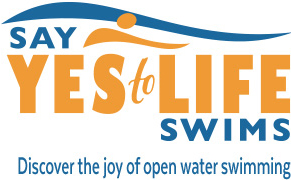
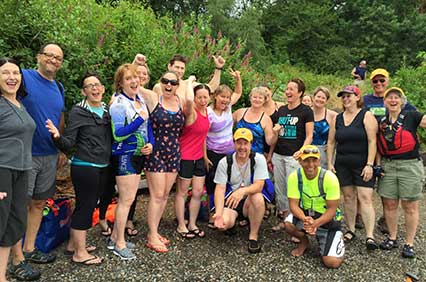
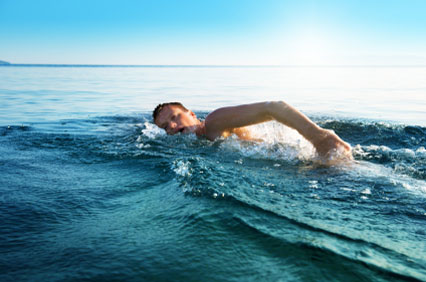
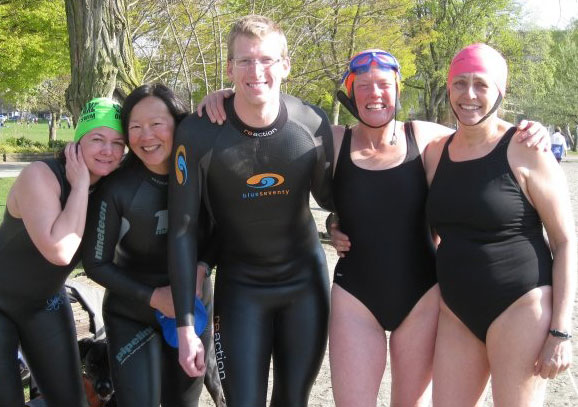
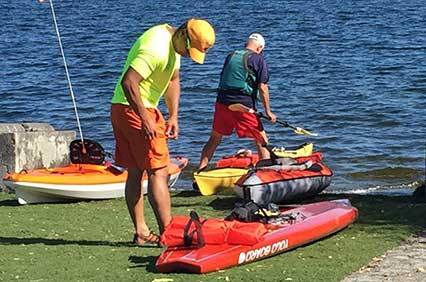

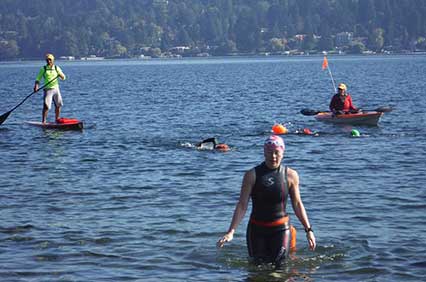
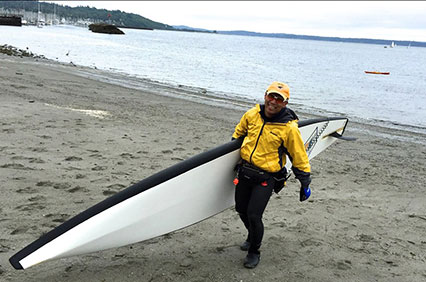
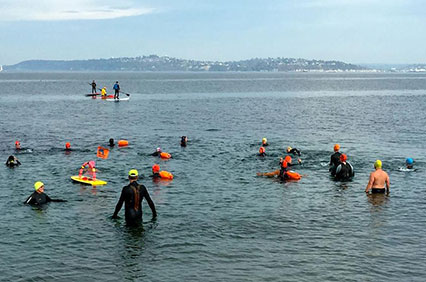

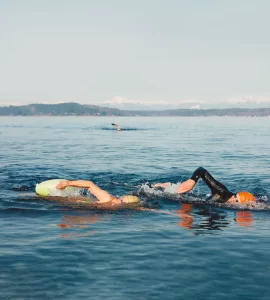
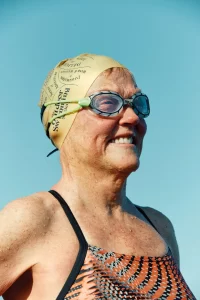 Wonderful feature in about local open water swimming:
Wonderful feature in about local open water swimming:


 On the first weekend this January, with Omicron raging and the skies pouring, I sat double-masked in the back of a conference room. It was the third and final day of the ASCA (American Swimming Coach’s Association) conference.
On the first weekend this January, with Omicron raging and the skies pouring, I sat double-masked in the back of a conference room. It was the third and final day of the ASCA (American Swimming Coach’s Association) conference. To stay on top of your game, you must train in the open water. Learning to deal with chop, waves, wind, and current will prepare you for your triathlon like nothing else.
To stay on top of your game, you must train in the open water. Learning to deal with chop, waves, wind, and current will prepare you for your triathlon like nothing else. New to the open water? This
New to the open water? This 


 Does the thought of swimming outdoors make you start hearing the soundtrack from the movie “Jaws”? If so, you are not alone. The good news is that countless swimmers have conquered their fears. They have discovered the uniquely rewarding activity of swimming in the natural world.
Does the thought of swimming outdoors make you start hearing the soundtrack from the movie “Jaws”? If so, you are not alone. The good news is that countless swimmers have conquered their fears. They have discovered the uniquely rewarding activity of swimming in the natural world.
 The May 2015 issue of Seattle Magazine includes an article featuring Say Yes! to Life Swims.
The May 2015 issue of Seattle Magazine includes an article featuring Say Yes! to Life Swims.